Study on the Factors of Kunming Temple Garden in the Period of Ming and Qing Dynasties
Qin LIU,Yi LIU
1.Yunnan Vocational and Technical College of Agriculture,Kunming 650031,China;2.Yunnan Agricultural University,Kunming 650201,China
1 Introduction
As one of the three ancient gardens in China,temple garden plays a key role in the history of ancientgardens in China.As time goes by,temple garden is not only a place for people to worship gods,but also a scenic sight.Planting landscape is an essential part of temple garden,and a key media to express religious belief.With the influence from Buddhism,Taoism,Islam,there are more temple gardens than other forms of gardens in Kunming during the Ming and Qing dynasties[1].Based on field investigation about the framework of landscape,layout of waters,characteristic of structure and plant furnishing in Tanhua temple,Black Dragon Pool,Masijid of Shuncheng,Haiyuan temple and Golden Shrine which are famous temple garden in Kunming,the artistic characteristics of temple garden were summarized in this paper.
Through field research of temple garden factors in Kunming during Ming and Qing times,the elemental traits of temple garden built at that time were summarized in this paper so as to provide some constructive references on how to protect and develop those temple garden now still exist in Kunming.
2 Studies on the element of temple garden
2.1 Mountains and waters framework
2.1.1 Piling of rocks Jin Xuezhi[2]hold the view that Daoism enlighten people's appreciation of piling of rocks.Daoism values"doing nothing"and thinks that nature itself is the most beautiful.The piling of rocks in Tanhua temple is a case in Point.Mountain Qi is empty and steep,and the top of the mountain is round instead of sharp.The various sizes of rocks,decorated with flowers,trees and grasses,compose a beautiful picture.(Fig.1a)
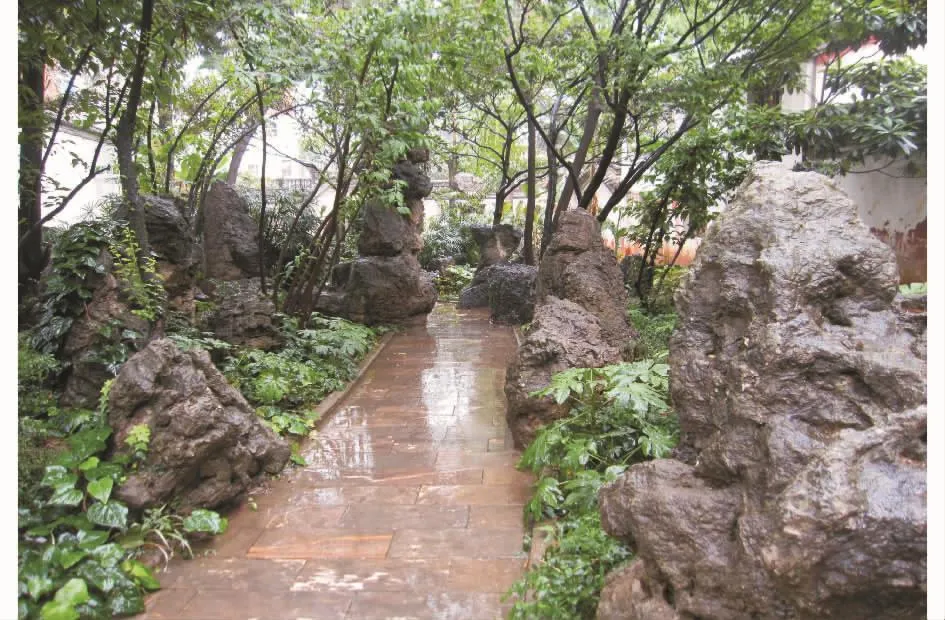
Fig.1a OverlappingrocksinTanhuaGarden
2.1.2 Lishui.Studies by Wushan[3]suggest that water scenery is more of symbolic significance than visual aesthetic feeling.The Free Life Pond in Black Dragon Pool in Kunming City reflects the significance of waters to the temple,not only for the daily use of monks butalso for tourists.The tank beatifies the environ ment and serves as a media for men and women to do good.(Fig.1b)Yuan Peizhi[4]believes that waters in garden temples in Kunming are static,and buildings form round travelling route.The Hunshuitan pool and Qingshuitan pool in Black Dragon Tank is in round shape.
Waters in most Islamic gardens are static to create a sort of peaceful atmosphere,and waters are scarce,which would render people a sincere feeling.The mosque in Shuncheng is small,whichmakes up the simple formation of Islamic garden and the static water makes people feel serene and sincere.(Fig.1c)
3 Architecture studies
3.1 PodiumPodium lies in the bottom of the entire building,and is generally square or rectangle platform.The podium includes two parts,railing and base.The railing is often for the surroundings of podium to prevent people from falling.It is flimsy because it does not carry anyweight.The base distributes theweight to the land since stone is waterproof.(Fig.1d)
3.2 Framework of attached columnThe framework of attached column,as the main body of temple structure,is composed by wall and wood column.The column is the major part to carry weight instead of the wall.Bracket is the special structure in wooden buildings in China and its major function is to support the roof and reduce the span of girders.The structure function of bracket during Ming and Qing dynasties gradually began to deteriorate,and the delicate bracket can be considered as a kind of decoration(Fig.2a).
3.3 Roof Roof is a part which shows strong religious significance.Jewelry of religious connotation,such as lotus and pearl,are decorated on the temples.Most buildings are featured with four slopes.The edge of roof isoften decorated with animals,such as dragon,phoenix,lion,seahorse.The number of animals is odd,often five(Fig.2b).
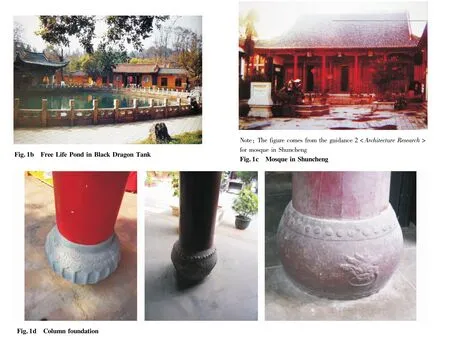
Fig.1 Overlappingrocics,Freelifepond,Shuncheng mosque,andColumnfoundation
4 Studies on choices and configuration of plants
4.1 Attitudes of religions to ward snatureWei Lei[5]and Liu Shanxiu[6]et al.deem that what the religion pursues is a kind of serenity,which makes people feel peaceful, which can be achieved by the balanced arrangement.Therefore,trees in temple gardens are panted in a balanced form.People are taught to love and to protect the nature,and to build a favorable surroundings for everyone.
4.2 Relation between temples and plantsThe religious thought is abstract and the plant is natural.People skillfully specify the abstract and consider the flowers and trees as gods so as to combine religion,buildings and plants together,which would carry profound cultural significance[7]and have energetic artistic effect.
4.3 Choices of plantsThere are always some plants related to gods in the Buddhist temple.Those plants are often considered as the incarnation of Buddhists[8].Those plants include Ficus religiosa,lotus,Corypha umbraculifea Linn,Michelia champaca L.,Plumeria rubra L.cv.Acutifolia,Shorea robusta,and Musella lasiocarpa,etc.Mostof those plantsare evergreen,which suggests that long live the Buddha.Ginkgo,also known as live fossil,is widely seen in the front of temple.The golden yellow,in particular,add strong religious atmosphere.
4.4 Plants arrangementPlants in the temple garden can be grown in cluster,grove or alone[9].Cluster plantation often can be seen in the general atmosphere.With regard to the general planning of temple,the areas for plants are larger than areas for buildings.Temples are hidden in the mountain to be far away from the city.For example,Taihe temple is surrounded by camphor,Liquidamba for mosana Hance,and evergreen mixed forest so as to hide the temple in the nature.(Fig.2c)
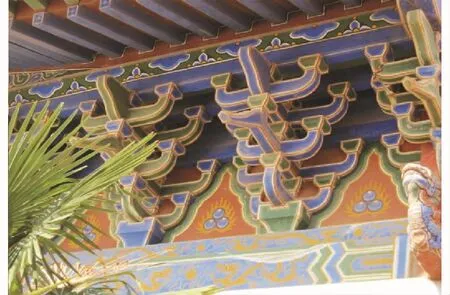
Fig.2a BracketofHaiyuantemple
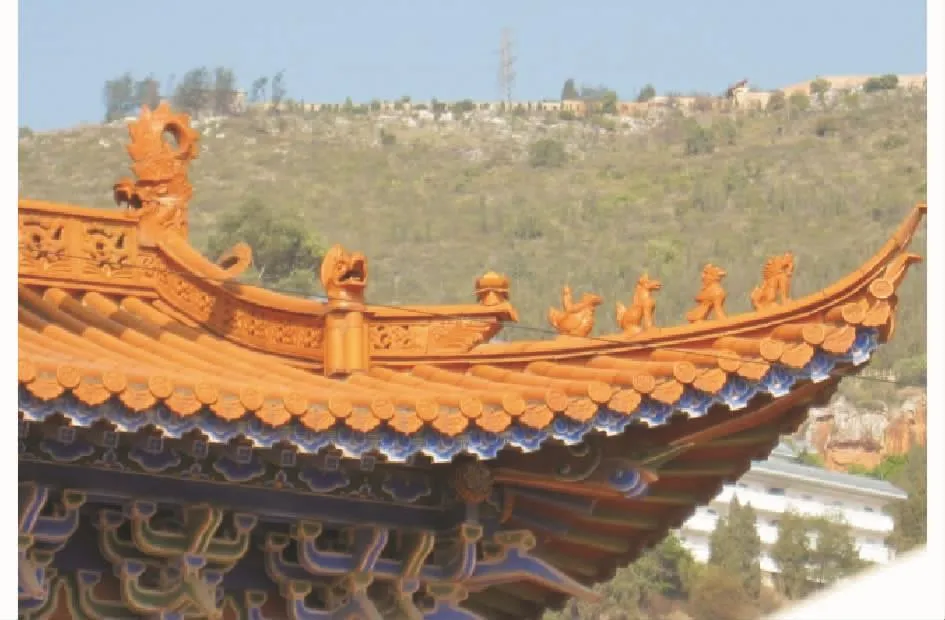
Fig.2b Animal smadeofstoneontheroof

Fig.2c ThesymbolicTaijiBaguainZhengqingTemple

Fig.2d TheroofofQingzhengtempleinShuncheng
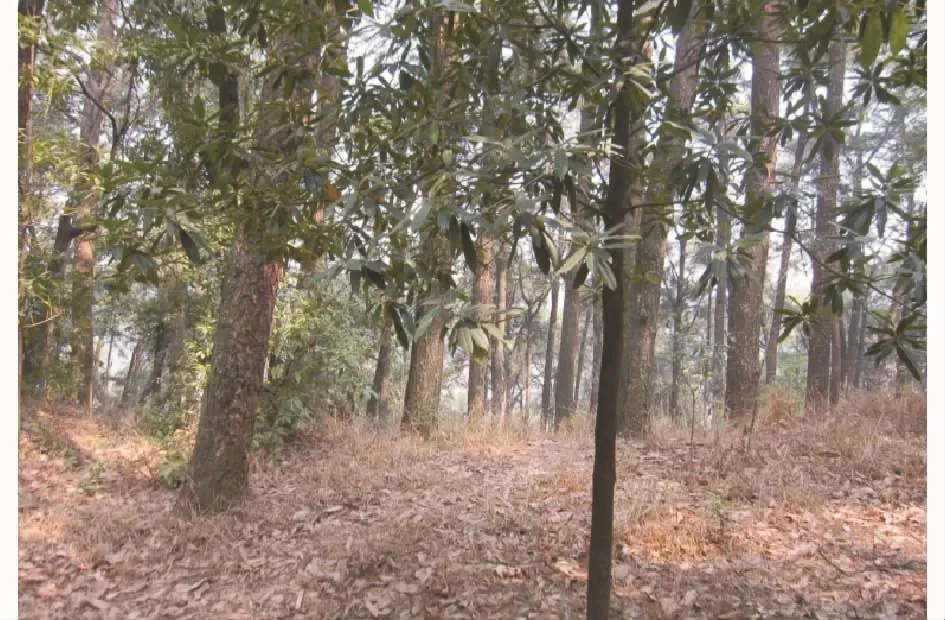
Fig.2e PlantsintheGoldenShrine
Groves are seen inside the temple for regional decoration by blocking buildings to produce an intense artistic atmosphere.The same kind of plants being grown will produce pure general atmosphere,while plants among different kinds of trees would make the scenery more colorful.Plants with beautiful flowers or sweet fragrance or ancient trees are often grown alone for ornament.(Fig.2 f-g)
4.5 ConclusionsThe mountain and water in the temple garden during Ming and Qing Dynasty fully display the beauty of nature.The column,framework and roof combine together to show the peculiarity of temple garden.The fake mountain,as a means to fully use the space,looks elegant.The waters,as an element for sightseeing,also make monks'life easier.The temple garden often chooses plants with religious connotation to reduce the cost of alien species.
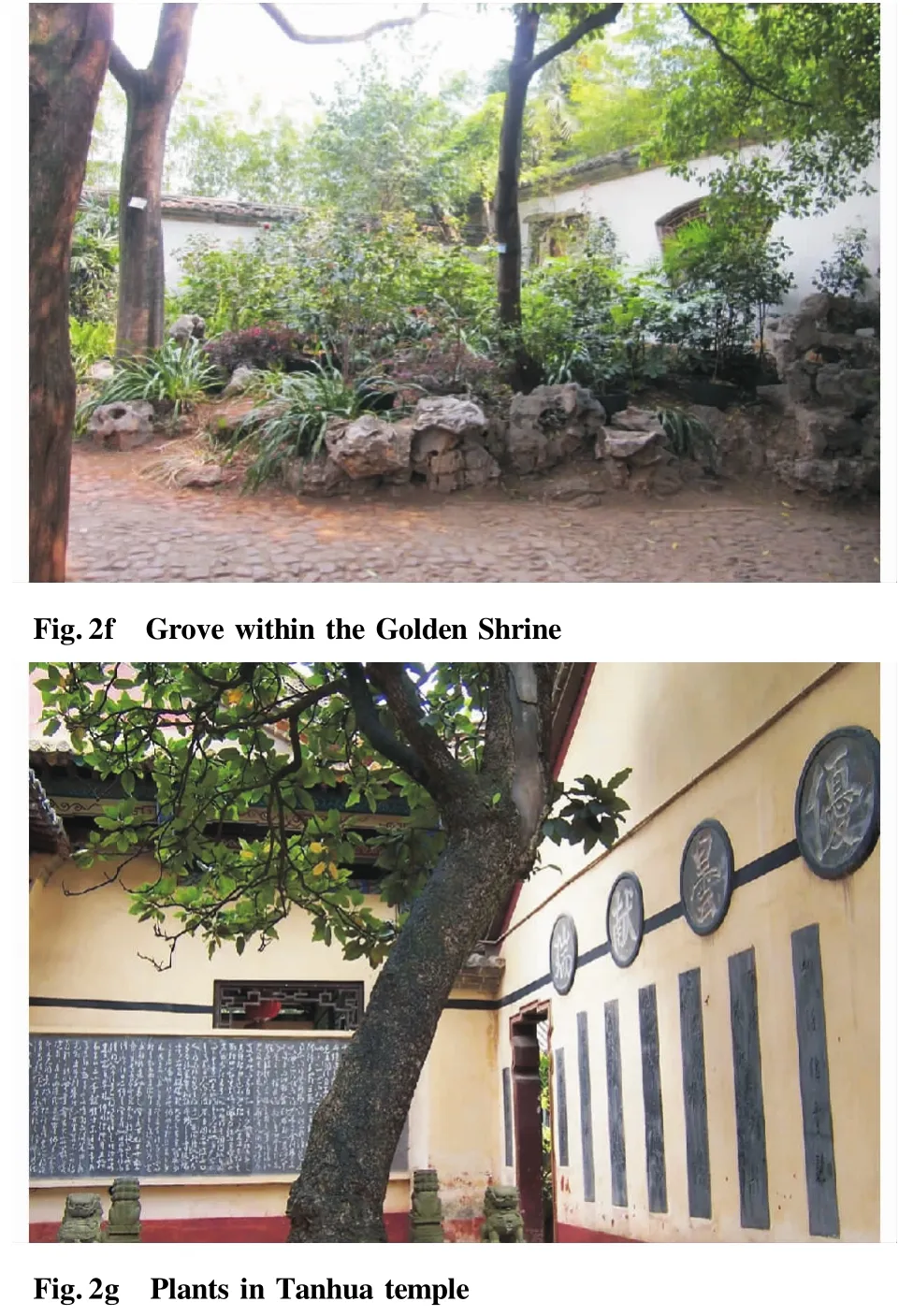
Fig.2 ThegardenfactorsinHaiyuantemple,zhengqingtemple,JindiantempleandshunchengMosque
4 Conclusions
The temple gardens in Ming and Qing Dynasties are a major branch of the Kunming garden system,and themajor constituent of the city Greenland system.It is an indispensable part of the cultural life of urban residents,which is same to the study result of Cao Ruji et al.[10]Through long time of development,the temple garden forms a peculiar shape,which provides valuable references.Studies by Jin Hexian[11],Wang Yunmei[12],Li Lin[13],He Xiaofeng[14],Sun Mingzhen[15],and Li Yuanyuan et al.[16],indicate that besides of coniferous trees,abundant of plants such as cherry,plum,Common jasmine orange,which not only beautify the temple garden,but alsomeet the cultural demand of temple to plants[17].It isworth considering how to coordinate the spiritual significance of temple garden andmodern culture,and how to absorb the essence of history and to protect it vigorously.
[1]Religious Affairs of Kunming.The history of Kunming buddhism[M].Kunming:The Nationalities Publishing House of Yunnan,2001.(in Chinese).
[2]JIN XZ.China park thesis[M].Beijing:China Architecture&Building Press,2005.(in Chinese).
[3]WU S.Study on the style of water design in Chinese garden[D].Suzhou University,2001.(in Chinese).
[4](Translator)YUAN PZ,YUANH.Tao Te Ching[D].Beijing:China Religious Culture Publisher,2003.(in Chinese).
[5]WEI L,WANG L,GAO C.Deep and serene poetic space——On the space art ofWuhan buddhist temple garden[J].Journal of Huazhong Agricultural University,2007(6):407-410.(in Chinese).
[6]LIU SX,HUOMD.Analysis on ornamental plants of temples[J].Guangdong Landscape Architecture,1991(2):29-32.(in Chinese).
[7]ZHOUWQ.The exploration of Chinese temple gardens[J].South China Agriculture,2007(2):3-7.(in Chinese).
[8]DU RJ,LIES,LIUGP.Landscape architecture design[M].Beijing:China Building Materials Press,1986.(in Chinese).
[9]CHEN B.Study on planting design in the parks and gardens of Hangzhou West Lake—Analysis on plant community structure,species composition and case study[D].Zhejiang University,2006.(in Chinese).
[10]CAORJ.The layoutand space organising of buddhist temples in Mt.Wutai of Shanxi[D].Taiyuan University of Technology,2005.(in Chinese).
[11]JIN HX,HUA HJ.The characteristics of plant landscape in temples[J].Chinese Landscape Architecture,2004,20(12):50-56.(in Chinese).
[12]WANGYM.Respect life and love nature—On the ecologicalethics ofbuddhism[J].Journal of Southeast University(Philosophy and Social Science),2001,3(4A):34-36.(in Chinese).
[13]LIL,MA JW.Exploration on plant landscape of temple garden in Kunming City[J].Modern Agricultural Science and Technology,2012(7):247-249.(in Chinese).
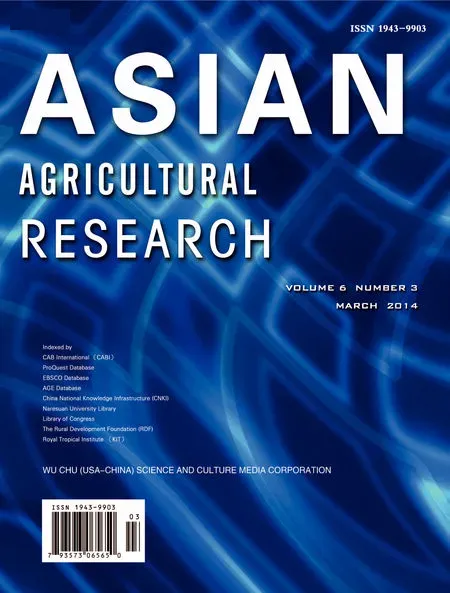 Asian Agricultural Research2014年3期
Asian Agricultural Research2014年3期
- Asian Agricultural Research的其它文章
- Land Use in M a'anshan Econom ic and Technological Development Zone:Based on the Land Survey of Typical Enterprises
- The Dynam ic Change in the Total Arable Land and its Driving Forces in Tong ling City of Anhui Province
- Research on the Evaluation Indicator System for Rural Green Building
- Use Efficiency of Rice Nutrient in the M arginal Areas of Jianghan Plain
- The Status and Evaluation of M ain Soil Nutrients in Xilin Gol Grassland
- Factors Influencing Farmers'W illingness to Participate in the New Vocational Training
